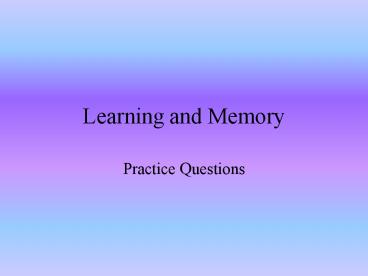Learning and Memory - PowerPoint PPT Presentation
1 / 9
Title:
Learning and Memory
Description:
Learning and Memory. Practice Questions. The Hebb rule states that a synapse will ... b. glutamate; neurons in the medial geniculate nucleus of the thalamus; to fail ... – PowerPoint PPT presentation
Number of Views:166
Avg rating:3.0/5.0
Title: Learning and Memory
1
Learning and Memory
- Practice Questions
2
The Hebb rule states that a synapse will be
strengthened if it repeatedly becomes active ___
the ___ neuron fires.
- a. at the same time presynaptic
- b. soon after presynaptic
- c. about the same time postsynaptic
- d. before postsynaptic
3
NMDA receptors
- a. control calcium ion channels.
- b. are found in highest concentration in the
mossy fibers of the field CA3. - c. detect the presence of magnesium.
- d. are blocked by glutamate.
4
Nitric oxide
- a. blocks the effects of calcium.
- b. may increase the number of glutamate
receptors. - c. may be produced in the dendritic spines.
- d. lasts for a long time and can diffuse the
entire length of a postsynaptic axon.
5
The release of ___ from ___ causes neurons in the
auditory cortex ___.
- a. acetylcholine neurons in the nucleus
basalis to become more sensitive to the auditory
input they are receiving - b. glutamate neurons in the medial geniculate
nucleus of the thalamus to fail to differentiate
between tones of different frequencies - c. calcium NMDA receptors to respond more
vigorously to the presence of nitric oxide - d. nitric oxide synthase presynaptic neurons
to increase protein synthesis necessary for
long-term potentiation
6
The synaptic changes that produce classically
conditioned emotional response occurs in the
- a. substantia nigra and the ventral tegmental
area. - b. auditory cortex and the nucleus accumbens.
- c. MGm and the basolateral amygdala.
- d. medial forebrain bundle.
7
The principal nuclei of the basal ganglia are the
- a. caudate nucleus, the putamen, and the globus
pallidus. - b. amygdala, the substantia nigra, and the
putamen. - c. neostriatum and the substantia nigra.
- d. caudate nucleus, globus pallidus, and
subthalamic nucleus.
8
Infusion of dopamine or cocaine through a
micropipette __ the rate of firing of CA1
pyramidal neurons if the infusions occurred ___
spontaneous bursts of action potential.
- a. increased during
- b. increased after
- c. decreased during
- d. decreased after
9
Learning and Amnesia
- Coming up next
- Final exam on
- Learning and Memory,
- Chapters 14 15































